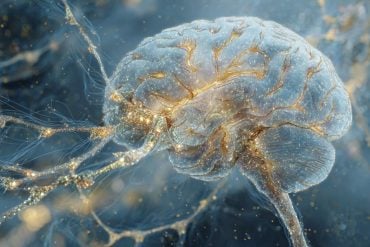Summary: New research reveals that sugar metabolism in brain cells may be a crucial defense against Alzheimer’s and related dementias. Scientists found that neurons in both flies and human models of tauopathy accumulate excess glycogen, which disrupts cellular stress management when it can’t be broken down.
Enhancing the enzyme glycogen phosphorylase (GlyP) helped redirect sugar metabolism into a protective pathway, reducing oxidative damage and extending lifespan in model organisms. The study also found that dietary restriction and certain drugs can boost GlyP activity, mimicking this effect.
Key Facts:
- Glycogen Accumulation: Neurons in Alzheimer’s models build up excess glycogen, worsening tau-related damage.
- Protective Pathway: Activating GlyP reroutes sugar into the PPP, reducing oxidative stress in neurons.
- Therapeutic Potential: Dietary restriction and drug treatments mimicking it improved brain health in both flies and human neurons.
Source: Buck Institute
A new study from scientists at the Buck Institute for Research on Aging has revealed a surprising player in the battle against Alzheimer’s disease and other forms of dementia: brain sugar metabolism.
Published in Nature Metabolism, the research uncovers how breaking down glycogen—a stored form of glucose—in neurons may protect the brain from toxic protein buildup and degeneration.

Glycogen is typically thought of as a reserve energy source stored in the liver and muscles. While small amounts also exist in the brain, particularly in support cells called astrocytes, its role in neurons has long been dismissed as negligible.
“This new study challenges that view, and it does so with striking implications,” says Professor Pankaj Kapahi, PhD, senior scientist on the study.
“Stored glycogen doesn’t just sit there in the brain; it is involved in pathology.”
The research team, led by postdoc Sudipta Bar, PhD, discovered that in both fly and human models of tauopathy (a group of neurodegenerative diseases including Alzheimer’s), neurons accumulate excessive glycogen.
More importantly, this buildup appears to contribute to disease progression. Bar says tau, the infamous protein that clumps into tangles in Alzheimer’s patients, appears to physically bind to glycogen, trapping it and preventing its breakdown.
When glycogen can’t be broken down, the neurons lose an essential mechanism for managing oxidative stress, a key feature in aging and neurodegeneration. By restoring the activity of an enzyme called glycogen phosphorylase (GlyP)—which kicks off the process of glycogen breakdown—the researchers found they could reduce tau-related damage in fruit flies and human stem cell-derived neurons.
Rather than using glycogen as a fuel for energy production, these enzyme-supported neurons rerouted the sugar molecules into the pentose phosphate pathway (PPP)—a critical route for generating NADPH (nicotinamide adenine dinucleotide phosphate) and Glutathione, molecules that protect against oxidative stress.
“By increasing GlyP activity, the brain cells could better detoxify harmful reactive oxygen species, thereby reducing damage and even extending the lifespan of tauopathy model flies,” said Bar.
Even more promising, the team demonstrated that dietary restriction (DR)—a well-known intervention to extend lifespan—naturally enhanced GlyP activity and improved tau-related outcomes in flies.
They further mimicked these effects pharmacologically using a molecule called 8-Br-cAMP, showing that the benefits of DR might be reproduced through drug-based activation of this sugar-clearing system.
“This work could explain why GLP-1 drugs, now widely used for weight loss, show promise against dementia, potentially by mimicking dietary restriction,” said Kapahi.
Researchers also confirmed similar glycogen accumulation and protective effects of GlyP in human neurons derived from patients with frontotemporal dementia (FTD), strengthening the potential for translational therapies.
Kapahi says the study emphasizes the power of the fly as a model system in uncovering how metabolic dysregulation impacts neurodegeneration.
“Work in this simple animal allowed us to move into human neurons in a much more targeted way,” he said.
Kapahi also acknowledges the Buck’s highly collaborative atmosphere as a major factor in the work. His lab, with expertise in fly aging and neurodegeneration, took advantage of proteomics expertise in the Schilling lab and the Seyfried lab (at Emory University) as well as the Ellerby lab which has expertise in human iPSCs and neurodegeneration.
Kapahi says this study not only highlights glycogen metabolism as an unexpected hero in the brain but also opens up a new direction in the search for treatments against Alzheimer’s and related diseases.
“By discovering how neurons manage sugar, we may have unearthed a novel therapeutic strategy: one that targets the cell’s inner chemistry to fight age-related decline,” he says.
“As we continue to age as a society, findings like these offer hope that better understanding—and perhaps rebalancing—our brain’s hidden sugar code could unlock powerful tools for combating dementia”.
Coauthors: Additional Buck collaborators include Kenneth A. Wilson, Tyler A.U. Hilsabeck, Sydney Alderfer, Jordan B Burton, Samah Shah, Anja Holtz, Enrique M. Carrera, Jennifer N. Beck, Jackson H Chen, Grant Kauwe, Tara E. Tracy, Birgit Schilling, and Lisa M. Ellerby. Other collaborators include Eric B. Dammer, Fatemeh Seifar and Nicholas T. Seyfried, Emory Center for Neurodegenerative Disease, Emory University School of Medicine, Atlanta, GA as well as Ananth Shantaraman, Department of Biochemistry, Emory University School of Medicine, Atlanta, GA
Funding: The work was supported by NIH grants R01AG038688, R21AG054121, AG045835, R01AG071995, R01AG070193, T32AG000266-23, R01AG061879, P01AG066591 and 1S10 OD016281. Other support came from the Hevolution Foundation, American Federation of Aging Research, the Larry L. Hillblom Foundation and the CatalystX award from Alex and Bob Griswold
About this metabolism and dementia research news
Author: Kris Rebillot
Source: Buck Institute
Contact: Kris Rebillot – Buck Institute
Image: The image is credited to Neuroscience News
Original Research: Closed access.
“Neuronal Glycogen Breakdown Mitigates Tauopathy via Pentose Phosphate Pathway-Mediated Oxidative Stress Reduction” by Sudipta Bar et al. Nature Metabolism
Abstract
Neuronal Glycogen Breakdown Mitigates Tauopathy via Pentose Phosphate Pathway-Mediated Oxidative Stress Reduction
Tauopathies encompass a range of neurodegenerative disorders, such as Alzheimer’s disease (AD) and frontotemporal lobar degeneration with tau inclusions (FTLD-tau), for which there are currently no successful treatments.
Here, we show impaired glycogen metabolism in the brain of a tauopathy Drosophila melanogaster model and people with AD, indicating a link between tauopathies and glycogen metabolism.
We demonstrate that the breakdown of neuronal glycogen ameliorates the tauopathy phenotypes in flies and induced pluripotent stem cell (iPSC)-derived neurons from people with FTLD-tau. Glycogen breakdown redirects glucose flux to the pentose phosphate pathway and alleviates oxidative stress.
Our findings uncover a critical role for the neuroprotective effects of dietary restriction (DR) by increasing glycogen breakdown.
Mechanistically, we show a potential interaction between tau protein and glycogen, suggesting a vicious cycle in which tau binding promotes glycogen accumulation in neurons, which in turn exacerbates tau accumulation which further disrupts cellular homeostasis.
Our studies identify impaired glycogen metabolism as a key hallmark for tauopathies and offer a promising therapeutic target in tauopathy and other neurodegenerative diseases.






